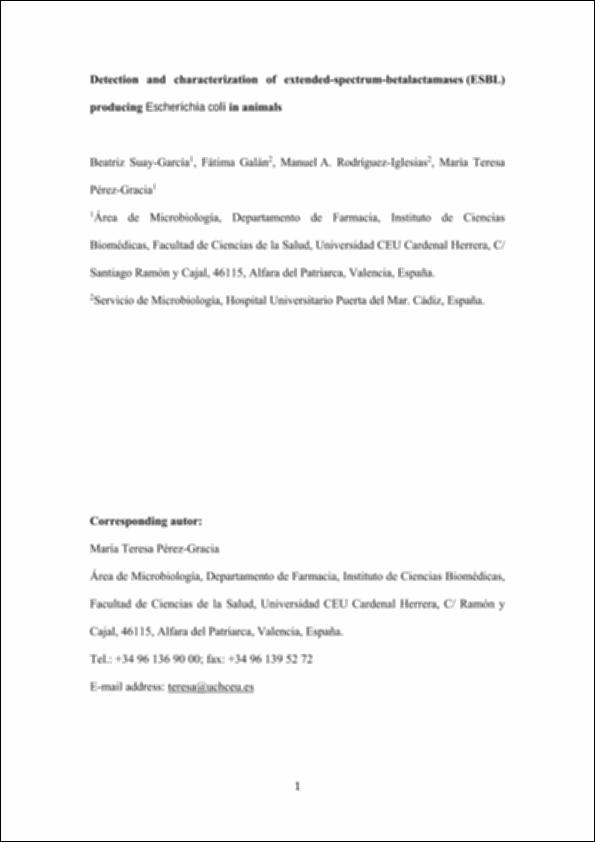Please use this identifier to cite or link to this item:
http://hdl.handle.net/10637/11660Detection and characterization of extended-spectrum Beta-Lactamases-Producing "Escherichia coli" in animals
| Title: | Detection and characterization of extended-spectrum Beta-Lactamases-Producing "Escherichia coli" in animals |
| Authors : | Suay García, Beatriz Galán Sánchez, Fátima Rodríguez Iglesias, Manuel A. Pérez Gracia, María Teresa. |
| Keywords: | Domestic animals.; Animals as carriers of disease.; Zoonosis.; Zoonoses.; Bacterias - Resistencia a los medicamentos.; Animales vectores.; Animales domésticos.; Escherichia coli - Resistencia a los medicamentos.; Escherichia coli - Drug resistance.; Farmacología molecular.; Molecular pharmacology.; Drug resistance in microorganisms. |
| Publisher: | Mary Ann Liebert |
| Citation: | Suay-García, B., Galán, F., Rodríguez-Iglesias, MA. & Pérez-Gracia, MT. (2019). Vector-Borne and Zoonotic Diseases, vol. 19, n. 2 (feb.), pp. 115-120. DOI: http://doi.org/10.1089/vbz.2018.2333 |
| Abstract: | The detection of multi-drug resistant bacteria is a growing problem, however, the role of domesticated animals in the propagation of antimicrobial resistance has barely been studied. The aim of this study was to identify ESBL-producing Escherichia coli strains in domestic animal feces in order to assess their antimicrobial resistance profile and carry out molecular characterization of the ß-lactamases. A total of 325 samples were collected from 8 animal species. Of these, 34 bacterial isolates were identified as E. coli. The antibiotic resistance profile of the E. coli strains was as follows: 100% resistant to amoxicillin, aztreonam, and cephalosporines; 58.8% resistant to nalidixic acid, ciprofloxacin and trimethoprim/sulphamethoxazole; 41.2% resistant to gentamicin and tobramycin; 11.8% resistant and 32.4% intermediate to cefoxitin, 97.1% sensible and 2.9% intermediate to amoxicillin/clavulanate; and 100% sensible to ertapenem, minocycline, imipenem, meropenem, amikacin, nitrofurantoin, phosphomycin and colistin. All 34 E. coli strains met criteria for ESBL production. In total, 46 ß-lactamase genes were detected: 43.5% blaTEM, 30.4% blaCTX-M (23.9% blaCTX-M-1 and 6.5% blaCTX-M-9) and 26.1% blaSHV (17.4% blaSHV-5 and 8.7% blaSHV-12). All the ß-lactamases were found in dogs except for 4 blaSHV found in falcons. No pAmpC genes were found. The high prevalence of ESBL-producing E. coli strains in animals could become a zoonotic transmission vector. |
| Description: | Este artículo se encuentra disponible en la página web de la revista en la siguiente URL: https://www.liebertpub.com/doi/10.1089/vbz.2018.2333?url_ver=Z39.88-2003&rfr_id=ori:rid:crossref.org&rfr_dat=cr_pub%20%200pubmed This is the pre-peer reviewed version of the following article: Suay-García, B., Galán, F., Rodríguez-Iglesias, MA. & Pérez-Gracia, MT. (2019). Detection and characterization of extended-spectrum Beta-Lactamases-Producing "Escherichia coli" in animals. Vector Borne and Zoonotic Diseases, vol. 19, n. 2, pp. 115-120, which has been published in final form at http://doi.org/10.1089/vbz.2018.2333 Este es el pre-print del siguiente artículo: Suay-García, B., Galán, F., Rodríguez-Iglesias, MA. & Pérez-Gracia, MT. (2019). Detection and characterization of extended-spectrum Beta-Lactamases-Producing "Escherichia coli" in animals. Vector Borne and Zoonotic Diseases, vol. 19, n. 2, pp. 115-120, que se ha publicado de forma definitiva en http://doi.org/10.1089/vbz.2018.2333 |
| URI: | http://hdl.handle.net/10637/11660 |
| Rights : | http://creativecommons.org/licenses/by-nc-nd/4.0/deed.es |
| ISSN: | 1530-3667 1557-7759 (Electrónico) |
| Issue Date: | 1-Feb-2019 |
| Center : | Universidad Cardenal Herrera-CEU |
| Appears in Collections: | Dpto. Farmacia |
Items in DSpace are protected by copyright, with all rights reserved, unless otherwise indicated.


